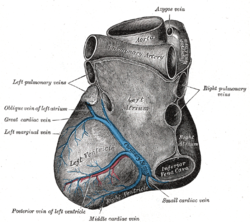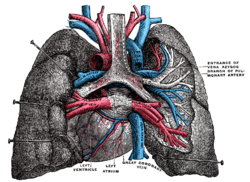Great cardiac vein
| Great cardiac vein | |
|---|---|
 Base and diaphragmatic surface of heart. (Great cardiac vein labeled at center left.) | |
 Pulmonary vessels, seen in a dorsal view of the heart and lungs. The lungs have been pulled away from the median line, and a part of the right lung has been cut away to display the air-ducts and bloodvessels (great coronary vein labeled at center bottom). | |
| Details | |
| Drains to | Coronary sinus |
| Identifiers | |
| Latin | vena cordis magna, vena cardiaca magna |
| TA98 | A12.3.01.003 |
| TA2 | 4159 |
| FMA | 4707 |
| Anatomical terminology | |
The great cardiac vein (left coronary vein) is a vein of the heart. It begins at the
anterior interventricular sulcus[1] before joining the oblique vein of the left atrium to form the coronary sinus[2]
upon the posterior surface of the heart.
Anatomy
Course
The great cardiac vein ascends along the
anterior interventricular sulcus[1] to the base of the ventricles.[citation needed] It then curves around the left margin of the heart to reach the posterior surface.[2]
Fate
Upon reaching the posterior surface of the heart,[3] the great cardiac vein merges with the oblique vein of the left atrium to form the coronary sinus.[2][3] At the junction of the great cardiac vein and the coronary sinus, there is typically a valve present. This is the Vieussens valve of the coronary sinus.[2]
Tributaries
The great cardiac vein receives tributaries from the
left atrium and from both ventricles: one, the left marginal vein, is of considerable size, and ascends along the left margin of the heart.[citation needed
]
References
![]() This article incorporates text in the public domain from page 642 of the 20th edition of Gray's Anatomy (1918)
This article incorporates text in the public domain from page 642 of the 20th edition of Gray's Anatomy (1918)
- ^ OCLC 1044772257.)
{{cite book}}: CS1 maint: location missing publisher (link - ^ ISBN 9783642659836.
- ^ PMID 32491498, retrieved 2023-01-05
External links
- Anatomy photo:20:11-0101 at the SUNY Downstate Medical Center - "Heart: Cardiac veins"
- Anatomy figure: 20:03-05 at Human Anatomy Online, SUNY Downstate Medical Center - "Anterior view of the heart."
